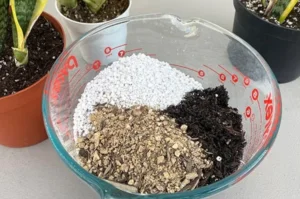If you’re a new plant enthusiast you might have a snake plant, which is also known as Dracaena trifasciata or mother-in-law’s tongue. They’re famously low-maintenance, making them ideal for forgetful waterers or busy plant parents. But how often should you water a snake plant? In this blog, we’ll exactly uncover that.
Getting to Know Your Snake Plant’s Watering Needs
Snake plants are succulents, meaning they hold water in their thick, fleshy leaves. This allows them to thrive in environments where many other plants would struggle. Their natural resilience to drought makes them a forgiving choice. However, understanding a few things will help you keep your snake plant at its best. But If you want to avoid overwatering and root rot, water your Snake Plant only once every two weeks. Wait until the soil is completely dry before watering again.
Factors Affecting Watering Frequency
Let’s look at the key things that influence how often you should water your snake plant:
1- Light Conditions:
Snake plants thrive in a variety of light conditions, from bright indirect light to low light. However, the amount of sunlight your plant receives can affect its water needs. In brighter conditions, the soil may dry out more quickly, requiring more frequent watering.
2- Temperature and Humidity:
Temperature and humidity levels play a significant role in determining watering frequency. In warmer, drier environments, snake plants may need more frequent watering to prevent dehydration.
3- Seasonal Changes:
Your snake plant’s watering needs change with the seasons. During the warmer months, when growth is most active, you may need to water more frequently. On the other hand, during cooler months, less frequent watering may be required.
4- Pot Size:
The size of your snake plant’s pot also affects its watering needs. Plants in larger pots generally require less frequent watering compared to those in smaller pots, as they have more soil volume to retain moisture.
5- Soil Type:
The type of soil your snake plant is planted in can impact its water retention capabilities. Well-draining soil is ideal for snake plants to prevent waterlogged conditions that can lead to root rot.
How Snake Plants Hold Water
Snake plants have adapted to survive in dry environments by storing water in their thick, succulent leaves. This natural water storage mechanism allows them to withstand periods of drought without frequent watering.
Can Snake Plants Absorb Water Through Leaves?
Technically yes, but it’s a very inefficient process. While snake plants can store water in their leaves, they primarily absorb moisture through their roots. However, misting the leaves occasionally can help increase humidity levels around the plant, promoting overall health.
Signs Your Snake Plant Needs Water
Want to know if it’s time to water? Here’s how your snake plant might tell you:
1- Dry Soil:
Insert your finger into the soil to check its moisture level. If it feels dry to the touch, it’s time to water your plant.
2- Wilting Leaves:
When snake plants are underwatered, their leaves may become soft and droopy. If you notice wilting leaves, it’s a clear indication that your plant needs water.
3- Yellowing Leaves:
Yellowing or browning leaves can also signal dehydration. While some degree of leaf discoloration is normal, excessive yellowing may indicate prolonged drought stress.
Frequently Asked Questions (FAQs):
Can I overwater my snake plant?
Yes, but overwatering can lead to root rot and other issues. It’s necessary to let the soil dry out between waterings to prevent soggy conditions.
Should I water my snake plant from the top or bottom?
Bottom watering, meaning placing your plant’s pot in water and allowing it to soak through the holes at the bottom, is the best option. If your snake plant’s pot doesn’t have drainage holes, you can water it using a jug or spray bottle (taking care to avoid getting water on the leaves).
Remember: It’s always better to underwater your snake plant than overwater it.






